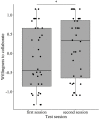Intranasal Oxytocin Improves Social Behavior in Laboratory Beagle Dogs (Canis familiaris) Using a Custom-Made Social Test Battery
- PMID: 35280140
- PMCID: PMC8907566
- DOI: 10.3389/fvets.2022.785805
Intranasal Oxytocin Improves Social Behavior in Laboratory Beagle Dogs (Canis familiaris) Using a Custom-Made Social Test Battery
Abstract
For a long time, oxytocin has been thought to have a generally positive effect on social cognition and prosocial behavior; however, recent results suggested that oxytocin has beneficial effects only under certain conditions. The aim of the present study was to explore potential associations between social competence and the effect of intranasal oxytocin on the social behavior of laboratory beagle dogs. We expected oxytocin treatment to have a more pronounced positive effect on dogs with lower baseline performance in a social test battery. Thirty-six adult dogs of both sexes received 32 IU intranasal oxytocin and physiological saline (placebo) treatment in a double-blind, cross-over design, with 17-20 days between the two sessions. Forty minutes after the treatment, dogs participated in a social test battery consisting of eight situations. The situations were carried out within one session and took 20-30 min to complete. Principal component analysis on the coded behaviors identified four components (Willingness to interact, Preference for social contact, Non-aversive response to nonsocial threat, and Non-aversive response to social threat). The subjects' behavior during the placebo condition was used to assess their baseline performance. We found that oxytocin treatment had a differential effect on the behavior depending on the baseline performance of the individuals in all components, but only two treatment × baseline performance interactions remained significant in a less sensitive analysis. In accordance with our hypothesis, oxytocin administration increased dogs' contact seeking and affiliative behaviors toward humans but only for those with low baseline performance. Dogs with low baseline performance also showed significantly more positive (friendly) reactions to social threat after oxytocin administration than after placebo, while for dogs with high baseline performance, oxytocin administration led to a more negative (fearful) reaction. These results indicate that similar to those on humans, the effects of oxytocin on dogs' social behavior are not universally positive but are constrained by individual characteristics and the context. Nevertheless, oxytocin administration has the potential to improve the social behavior of laboratory beagle dogs that are socially less proficient when interacting with humans, which could have both applied and animal welfare implications.
Keywords: dog; individual differences; laboratory beagle; oxytocin; social behavior.
Copyright © 2022 Turcsán, Román, Lévay, Lendvai, Kedves, Petró and Topál.
Conflict of interest statement
VR, RK, GL, and BL are full-time employees of Gedeon Richter Plc. This study received funding from Gedeon Richter Plc. The funder had the following involvement with the study: Gedeon Richter Plc. provided laboratory space for the experiment and covered the costs associated with the care of laboratory beagles. The remaining authors declare that the research was conducted in the absence of any commercial or financial relationships that could be construed as a potential conflict of interest.
Figures




Similar articles
-
Nasally-Administered Oxytocin Has Limited Effects on Owner-Directed Attachment Behavior in Pet Dogs (Canis lupus familiaris).Front Psychol. 2017 Sep 29;8:1699. doi: 10.3389/fpsyg.2017.01699. eCollection 2017. Front Psychol. 2017. PMID: 29033879 Free PMC article.
-
Differential effects of oxytocin on social sensitivity in two distinct breeds of dogs (Canis familiaris).Psychoneuroendocrinology. 2016 Dec;74:212-220. doi: 10.1016/j.psyneuen.2016.09.010. Epub 2016 Sep 20. Psychoneuroendocrinology. 2016. PMID: 27665081
-
Social Stimulation by the Owner Increases Dogs' (Canis familiaris) Social Susceptibility in a Food Choice Task-The Possible Effect of Endogenous Oxytocin Release.Animals (Basel). 2022 Jan 25;12(3):296. doi: 10.3390/ani12030296. Animals (Basel). 2022. PMID: 35158620 Free PMC article.
-
Neurobiological underpinnings of dogs' human-like social competence: How interactions between stress response systems and oxytocin mediate dogs' social skills.Neurosci Biobehav Rev. 2016 Dec;71:198-214. doi: 10.1016/j.neubiorev.2016.08.029. Epub 2016 Sep 1. Neurosci Biobehav Rev. 2016. PMID: 27593441 Review.
-
The role of oxytocin in relationships between dogs and humans and potential applications for the treatment of separation anxiety in dogs.Biol Rev Camb Philos Soc. 2017 Feb;92(1):378-388. doi: 10.1111/brv.12235. Epub 2015 Nov 9. Biol Rev Camb Philos Soc. 2017. PMID: 26548910 Review.
Cited by
-
Neurobiology of Maternal Behavior in Nonhuman Mammals: Acceptance, Recognition, Motivation, and Rejection.Animals (Basel). 2022 Dec 19;12(24):3589. doi: 10.3390/ani12243589. Animals (Basel). 2022. PMID: 36552508 Free PMC article. Review.
References
LinkOut - more resources
Full Text Sources

